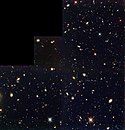Głębokie Południowe Pole Hubble’a
Głębokie Południowe Pole Hubble’a (ang. Hubble Deep Field South, w skrócie HDF-S) – obraz niewielkiego obszaru nieba południowego w gwiazdozbiorze Tukana, bazujący na serii obserwacji Kosmicznym Teleskopem Hubble’a.
Wykonane zdjęcie jest złożeniem kilkuset osobnych ekspozycji wykonywanych przy pomocy Wide Field and Planetary Camera 2 w ciągu 10 dni we wrześniu i październiku 1998.
Obraz HDF-S bardzo przypomina wykonane 3 lata wcześniej Głębokie Pole Hubble’a, co umacnia zasadę kosmologiczną, która mówi, że Wszechświat w wielkich skalach jest jednorodny.
Zobacz też
Linki zewnętrzne
Media użyte na tej stronie
The deepest visible/ultraviolet light image of the universe ever taken, revealing galaxies down to 30th magnitude. Glaring fiercely across 12 billion light-years of space is the brilliant beacon of a distant quasar (z=2.2). Most of the galaxies in this view lie between us and the quasar. The image was taken with the camera on the Space Telescope Imaging Spectrograph (STIS). The STIS recorded how numerous invisible intervening clouds of hydrogen gas affected the quasar's light. Some of the galaxies in the image may be linked to these clouds.

